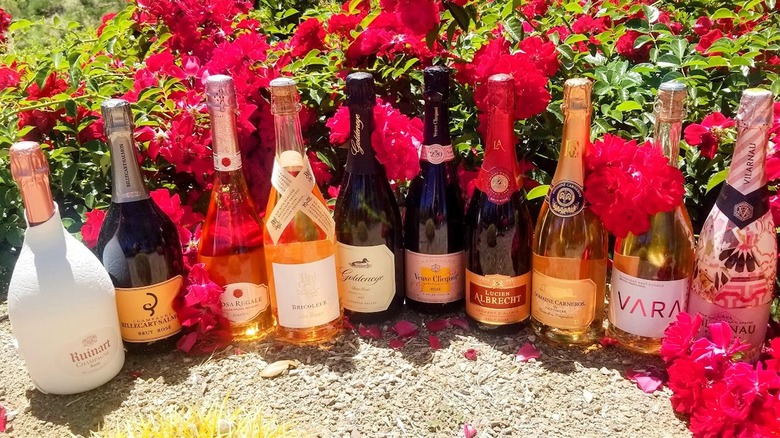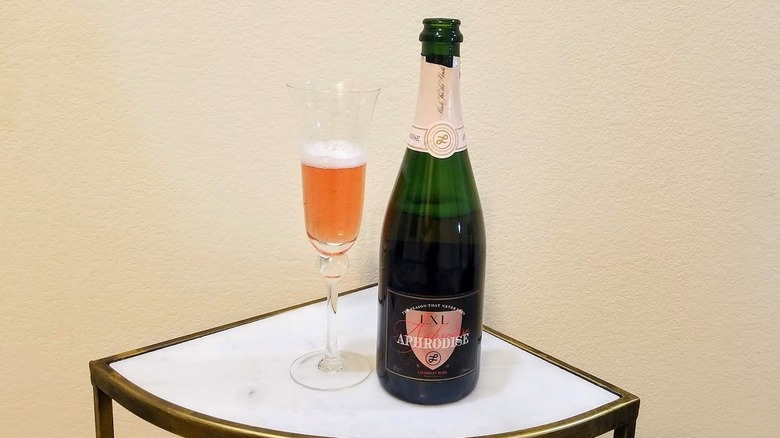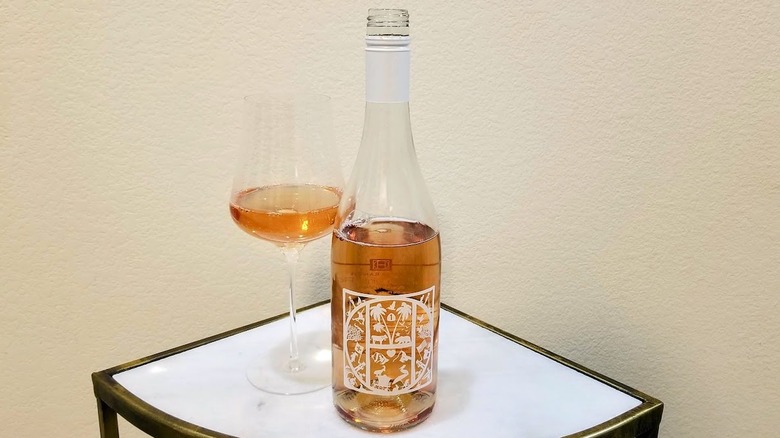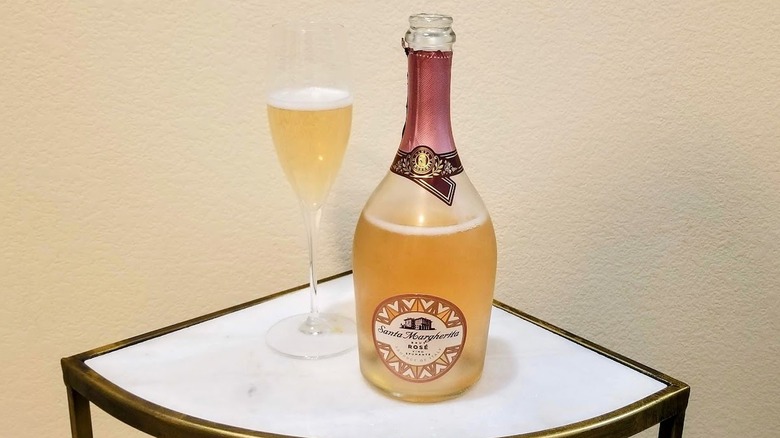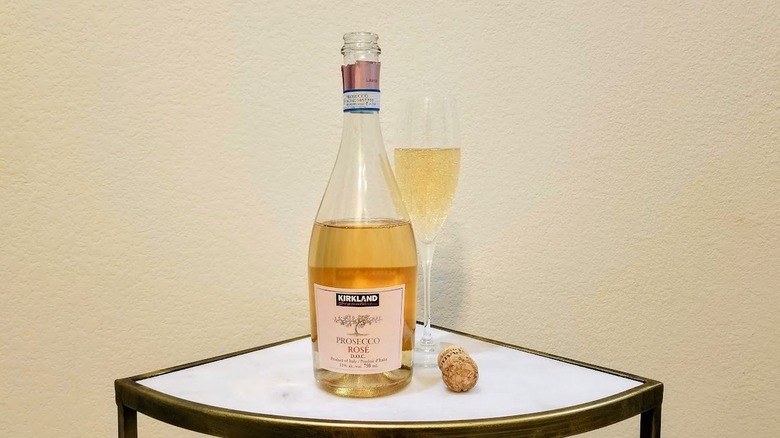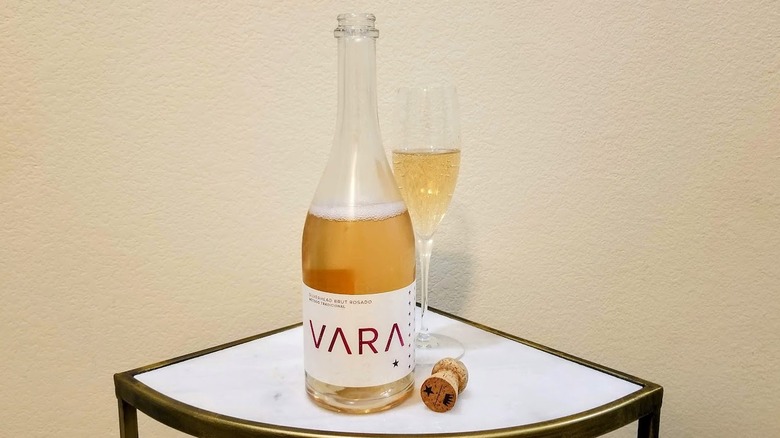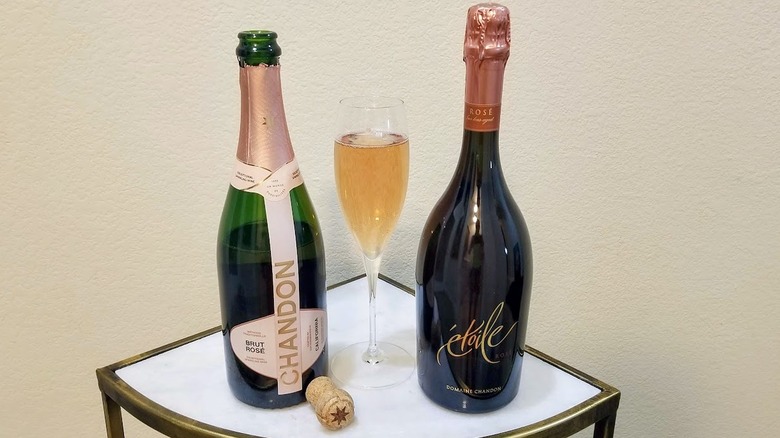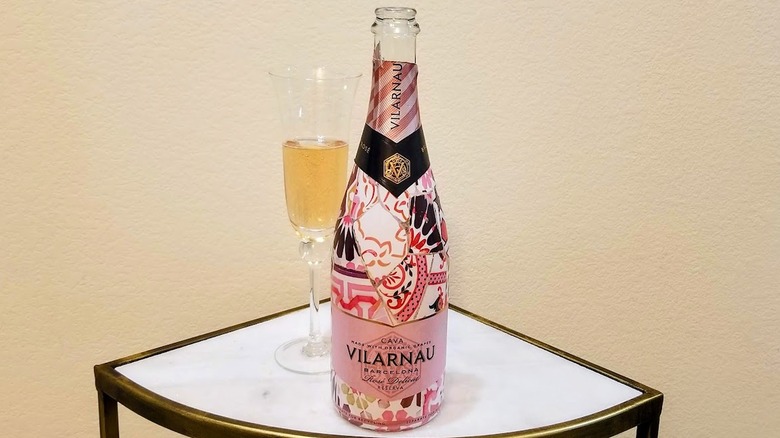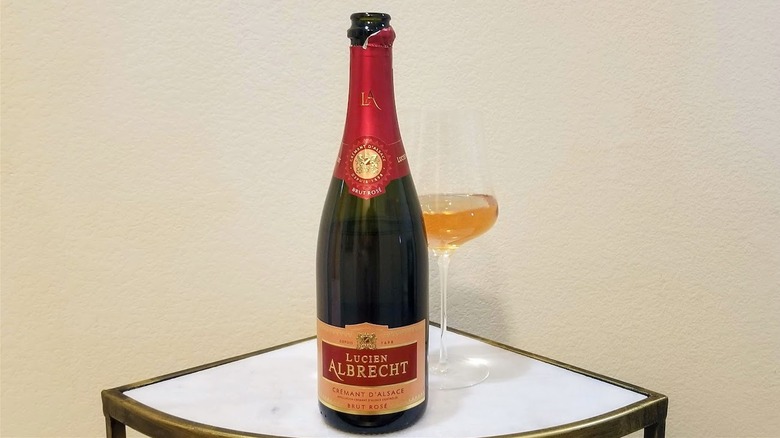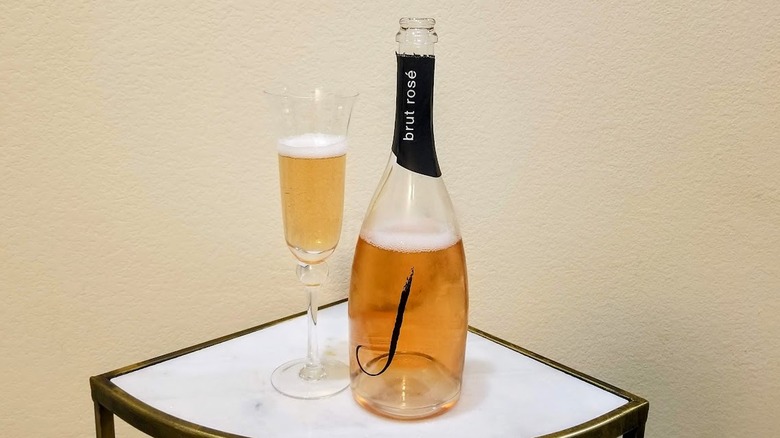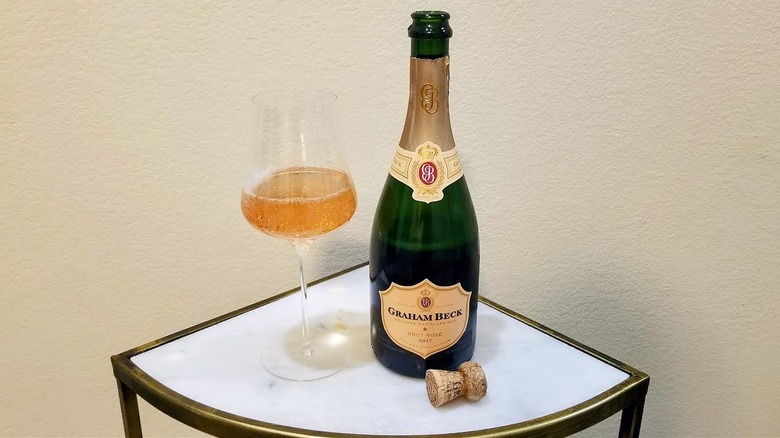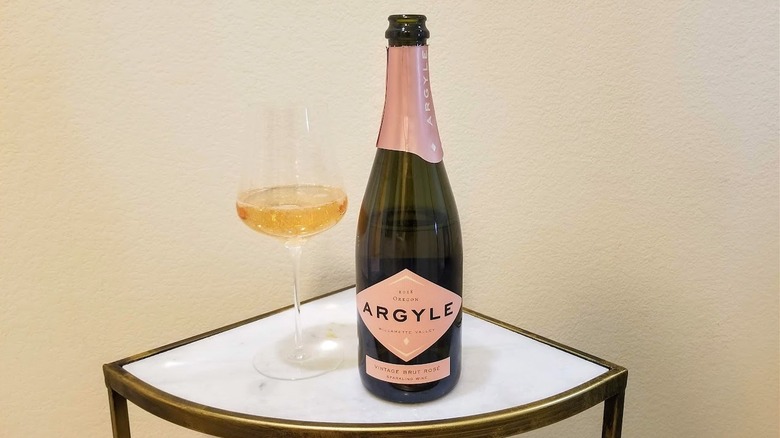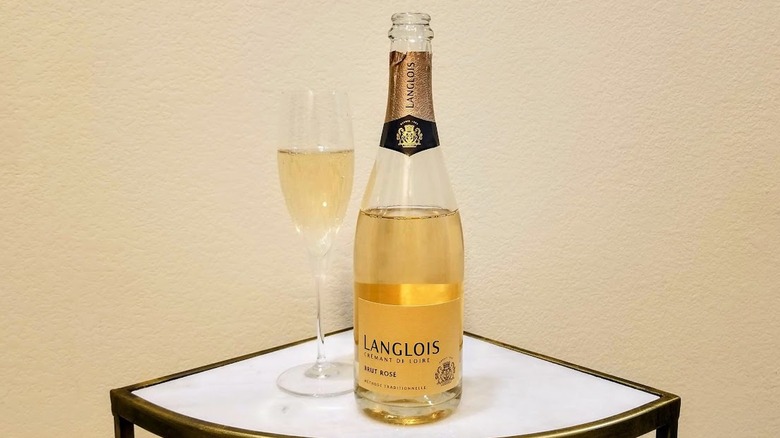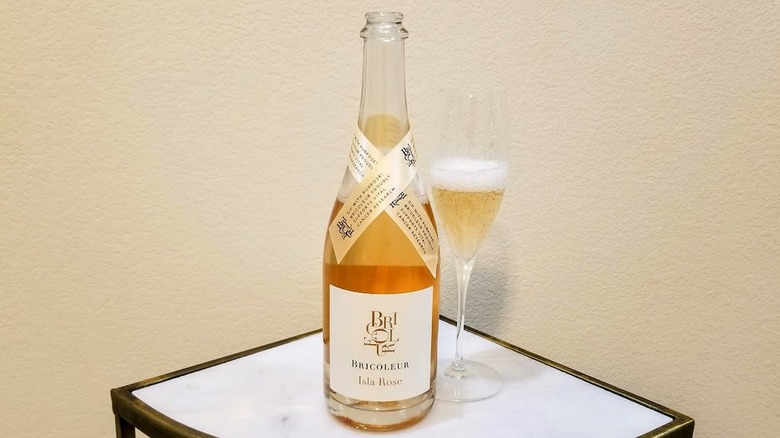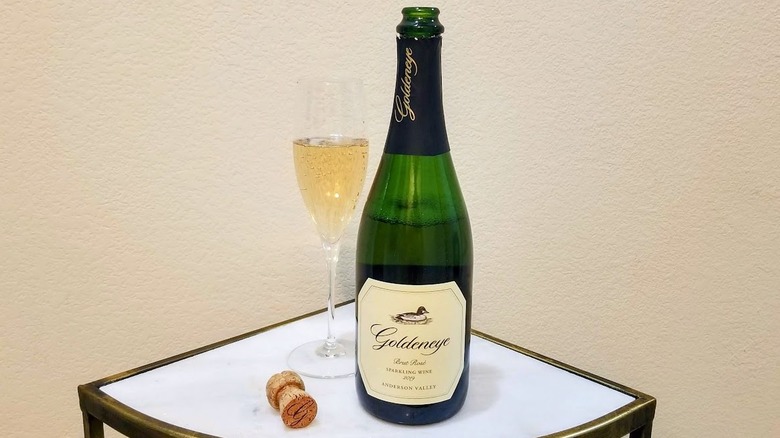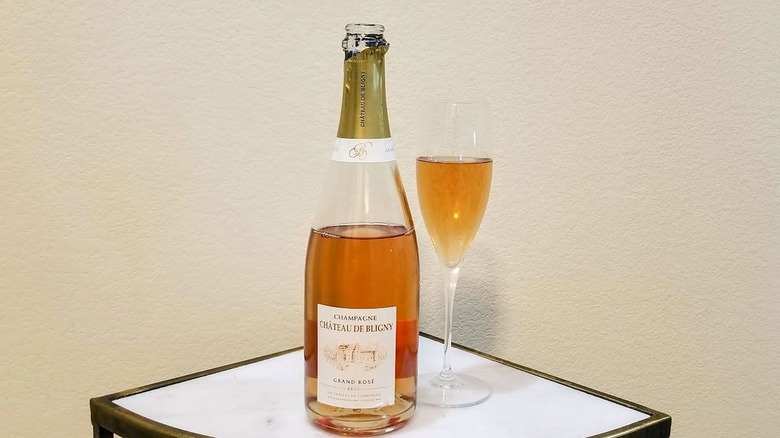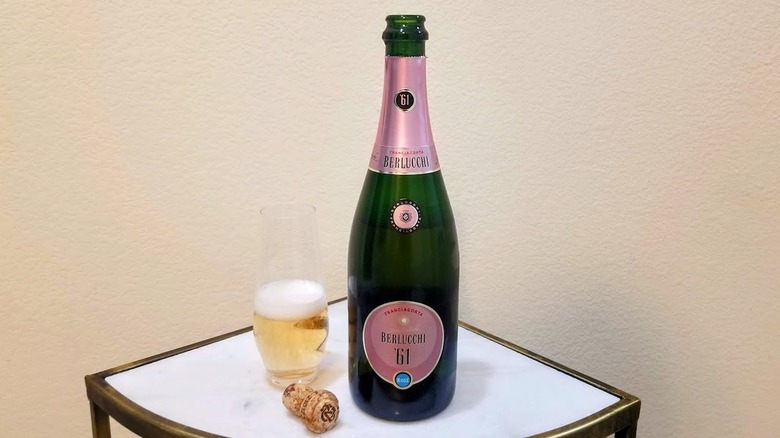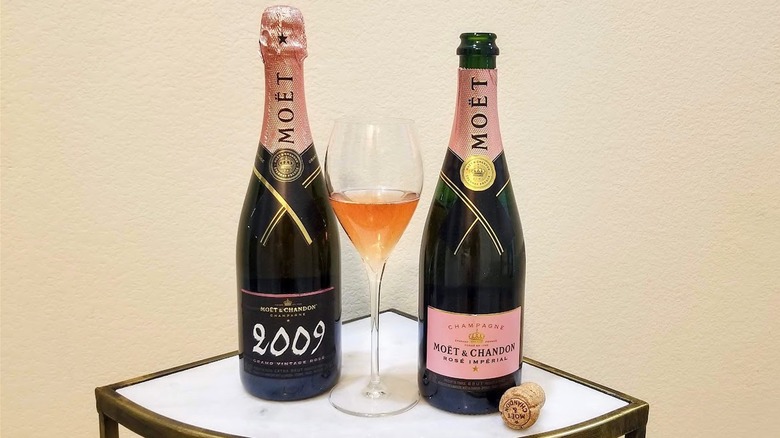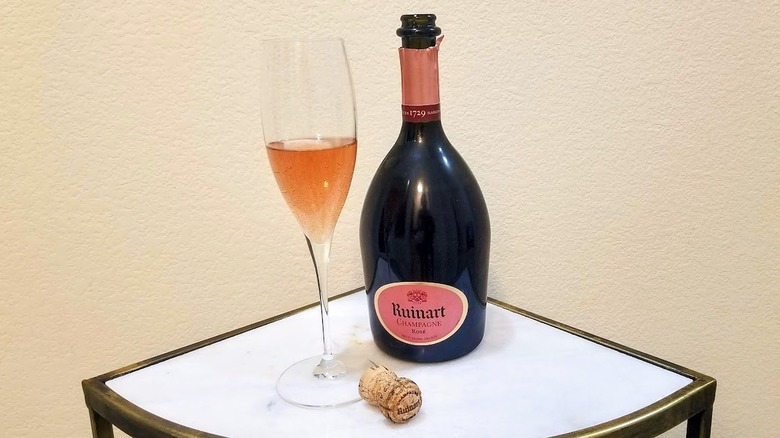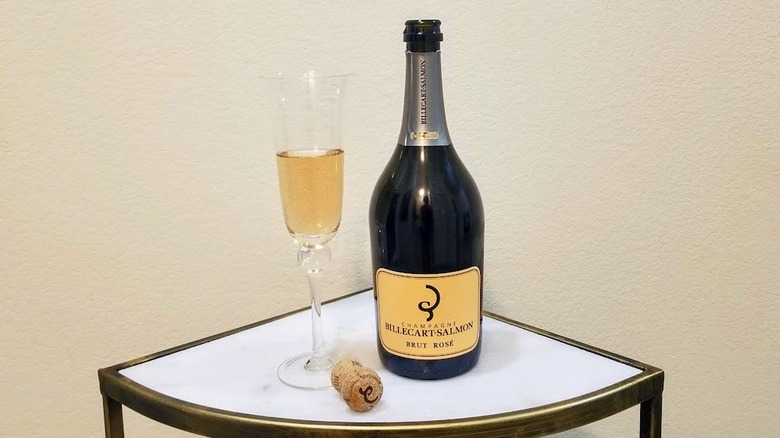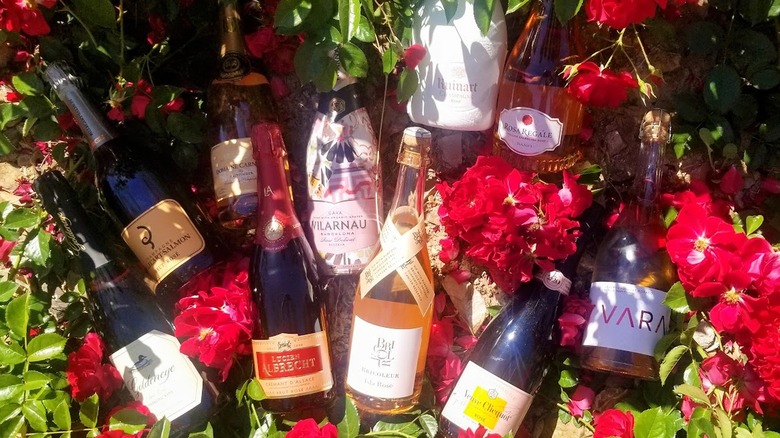A Sommelier Ranked 21 Sparkling Rosé Wines From Worst To Best
Sparkling rosé is a refreshing, bubbly wine. It can be fun and light, like your favorite pink prosecco, or complex and highly gastronomic, like a well-aged bottle of Champagne. Today, an increasing number of wineries are offering sparkling rosé wines, producing a range of styles hoping to lure the attention of consumers.
However, just as not all types of sparkling wine are alike, not all bottles of sparkling rosé are the same, either. Some brands employ the production method traditionally used for Champagne — allowing the secondary fermentation to create bubbles inside the bottle — while other sparkling rosé producers utilize a tank. Though production styles can vary, the overall product should deliver on the expectations of providing lively bubbles with balance, structure, and style.
With so many sparkling rosé wine bottles on the market, I decided to rank some prominent brands of this bubbly wine. After compiling a list of 21 sparkling rosé wine brands, I ranked the selected entries based on a variety of factors, including authenticity, production style, provenance, and value (among others). I also conducted firsthand taste tests of each bottle — guided by my experience as a Certified Sommelier — to determine the top sparkling rosé wine brand.
Some recommendations are based on first-hand impressions of promotional materials and products provided by the manufacturer/distributor/etc.
21. LXL Aphrodise
LXL Aphrodise is the creation of tech entrepreneur turned winemaker Frank Shilling and his partner, Gabi Petrylaite. Launched in 2022, the duo's xinomavro-based sparkling rosé wine from Greece markets itself as a luxury sparkling wine perfect for sipping poolside with friends. While we appreciate the frivolity that Aphrodise hopes to evoke, this sparkling rosé lacks greater nuance.
Though the brand states there's "low residual sugar" in its sparkling rosé, the 18.3 grams of residual sugar per liter designate the wine as off-dry. Unfortunately, it lacks the necessary freshness to balance the noticeable candied sweetness, so this brand ranks below the other brands.
20. Halter Ranch
Produced at the expansive Halter Ranch estate in Paso Robles, California, Halter Ranch Winery crafts refined wines from 100% certified organic vineyards. Taking a hands-off approach to allow the terroir to speak through the wines, Halter Ranch crafts its Effervescent Rosé from grenache, picpoul blanc, and mourvédre grapes.
The result is a dry sparkling rosé with layers of ripe berries, melon, papaya, and apricot. However, the wine lacks the vibrancy that thousands of dancing bubbles bring to a glass of sparkling rosé. The wine's subtle fizz of natural CO2 quickly dissipates, which places this sparkling rosé wine brand at second-to-last.
19. Santa Margherita
Italy's Santa Margherita Sparkling Rosé blends glera grapes with chardonnay and a splash of malbec. Santa Margherita also uses the Charmat production method, where the wine transforms into sparkling rosé inside a pressurized tank, generating bubbles. It is bottled after six months of aging, delivering freshness with fruit-froward characteristics.
Now, this sparkling rosé may be a fine example of why sparkling wine and brunch are a match made in heaven, as it easily pairs with eggs benedict, a vegetable frittata, or a pile of chicken and waffles. Unfortunately, it doesn't really distinguish itself in a significant way from other sparkling rosé options. Since this brand tends to cost much more than the Kirkland Signature Rosé Prosecco ranked just above it, Santa Margherita comes near the bottom of sparkling rosé wines.
18. Kirkland Signature
One of the many reasons to love Costco is the wholesaler's store brand Kirkland Signature wines. Though its products come from some of the most sought-after regions in the world and are generally well-made, Kirkland Signature wines are eminently affordable. This includes its Kirkland Signature Rosé Prosecco, which may cost you less than $10 (depending on the location).
This glera and pinot noir-based sparkling rosé is red fruit-forward and approachable — even with 12 to 17 grams per liter of sugar — and has enough acidity to ensure balance. Costco's option isn't overly sophisticated by any means, which is why it places near the bottom. But it's certainly drinkable, especially for such a low price.
17. VARA
VARA is a different kind of American winery. Based in New Mexico, the winery crafts its products from fruit grown throughout America and Spain under the direction of a team of industry veterans, including well-regarded winemakers Bob Lindquist and Laurent Gruet. VARA's American Silverhead Brut Rosado is crafted from an unlikely combination of syrah grown in the state of Washington with chardonnay to create this unique sparkling rosé.
With a lively effervescence, this wine has bright acidity and fruit-forward flavors of nectarine, strawberry, and quince. It may rank in the bottom half, but its lower placement is more of a reflection of the higher-ranked sparkling rosé wine brands rather than a knock on VARA. In that sense, it's a relatively solid choice — even if it's not the most intricate or complex sparkling rosé I've encountered.
16. Chandon California
Sister winery to the famed Moët & Chandon Champagne house, Chandon California began in Napa Valley in 1973. The winery produces a broad portfolio of sparkling wines in various styles that suit a wide range of palates from dry to sweet selections — like its brut rosé. Chandon's Brut Rosé blends chardonnay, pinot noir, and pinot meunier grapes that are sourced from throughout California and ages 12 months en tirage (or in the bottle) after the completion of secondary fermentation.
By and large, this sparkler is a fine example of California sparkling wine. The aging lends a subtle yeastiness that melds with cranberry, raspberry, and tangerine. Then again, this brut rosé isn't distinct enough to rank any higher given the quality of sparkling rosé wine brands on this list. Consequently, it places just above the Vara and Kirkland options.
15. Vilarnau
The beauty of cava is that its production method is similar to the wines of Champagne. However, a significant difference between cava and Champagne is that cava generally costs a fraction of what the French charge for its prestigious bubbles. This means the Brut Reserva Rosé Delicat Organic from Vilarnau is much more affordable than a Champagne counterpart.
Vilarnau crafts 100% organic cava from vineyards within DO Penedès in Spain. Its Brut Reserva Rosé Delicat Organic combines garnacha and pinot noir that's aged for 15 months in the bottle. The time in the bottle lends texture and creaminess to the red berries and wildflower-filled wine, making this a well-balanced, approachable cava. Unfortunately, it didn't stand out much from the crowd during my taste test, and I couldn't place this admittedly decent sparkling rosé wine above the higher-ranked brands.
14. Lucien Albrecht
Maison Lucien Albrecht is one of France's leading producers of quality sparkling Crémant d'Alsace wines. Lucien Albrecht Brut Rosé utilizes 100% hand-harvested pinot noir fruit grown in rocky, mineral-rich hillside vineyards within the southern Alsace region, which gives a note of crushed stone to this effervescent wine.
Opening with a frothy, lively mousse, this sparkling rosé wine is approachable, showing crisp freshness and flavors of red fruits and wild herbs that are food-friendly and tasty. While not the most complex offering in the selections I tried — hence, its place in the ranking — this sparkling rosé is still enjoyable, so it comes in the middle of this list.
13. J Vineyards & Winery
J Vineyards & Winery showcases Russian River Valley wine's unique terroir and biodiversity. Under the direction of winemaker Nicole Hitchcock, J crafts sparkling wines with authentic character using a traditional method of production, including a brut rosé sparkling wine.
J Russian River Valley Brut Rosé opens with aromas of candied red fruits, blanched almonds, and wildflowers. This is followed by a palate rich with nectarines, ripe berries, and a note of crushed stone minerality. This sparkling rosé is refreshing, bright, and balanced, and pairs nicely with summer salads, roasted salmon, or light pasta dishes. J Vineyards & Winery may rank in the middle of the pack, but it's a solid sparkling rosé wine brand you'll likely enjoy.
12. Graham Beck
The name Methode Cap Classique was adopted in South Africa for making traditional sparkling wine when France made it illegal to use the term Champagne on bottles outside the nation. With that in mind, Graham Beck is a pioneer in Cap Classique (or South Africa's sparkling wine) production, so it's no surprise the brand sells a variety of delicious sparkling rosé wines made with that method.
This well-regarded winery produces a range of well-made sparkling rosé wines, helping it place in the middle of these rankings. For its Brut Rosé, Graham Beck presses and ferments chardonnay and pinot noir fruit together. The wine opens with a zesty mousse of bubbles, followed by notes of crushed stone, wild berries, and woody herbs. It has a lovely rusticity and a well-structured palate; unfortunately, the higher-ranked sparkling rosé wine brands were just that much better.
11. Argyle
Argyle is a signature producer of Willamette Valley wines. It began in 1987 when Texas native Rollin Soles began crafting traditional method sparkling wines in Willamette's Dundee Hills. Today, the winery crafts still and sparkling wines from fruit grown throughout the valley by winemaker Nate Klostermann.
The brand's sparkling wines reveal structured complexity with a well-rounded mouthfeel, particularly Argyle's extended tirage sparklers that age in the bottle on the lees for an extended time. This gives a concentrated richness to the palate, which is evident in its sparkling rosé. Argyle's Vintage Brut Rosé shows tangerine, red berry, and marzipan, and would pair perfectly with our citrus almond tart. It may just miss the top tier, but the sparkling wine's flavor and the winery's refined production methods help earn this sparkling rosé wine brand a well-placed ranking overall.
10. Langlois
Langlois Château Crémant de Loire is a delicate, cabernet franc-based, traditional method sparkling wine from certified Terra Vitis (Sustainable Viticulture) vineyards in the Loire Valley of France. With a salmon-colored hue, its brut rosé's mousse of fine bubbles caresses the palate, delivering an elegant mouthfeel that's easy to get lost in. It's the type of sparkling rosé that pairs well with a summer vegetable salad with jasmine rice.
This wine opens with the classic characteristics of cabernet franc, including fragrant purple flowers and soft herbs, leading to red fruit flavors. It's an appealing wine from responsibly farmed vineyards, which helps it rank in the middle of this list.
9. Bricoleur
Russian River Valley's Bricoleur Vineyards is a relatively new brand on the scene, founded in 2020. However, the winery has quickly made its presence known, producing delicious, well-crafted wines, including its Isla Rosé Brut Rosé. Made from sustainably grown pinot noir and chardonnay fruit, this sparkling wine is refreshing and highly quaffable with a lively mousse and fruity flavors of white peach, melon, and brioche.
Taking on the Sip with Purpose motto, a portion of every bottle of brut rosé sold is donated to the V Foundation for cancer research. Since I love enjoying a tasty bottle of a well-produced and luscious sparkling rosé while also giving back, Bricoleur earns high marks.
8. Goldeneye
Goldeneye captures rugged Anderson Valley's alluring rusticity, creating character-driven cool-climate wines. Utilizing the traditional method of production, Goldeneye Brut Rosé sparkling wine blends chardonnay and pinot noir grown throughout the far-northern California area to create a multidimensional, multi-layered sparkling wine with structure, freshness, and balance.
Two years of bottle aging en tirage gives this sparkler a nutty, yeasty note that marries with red fruits, ripe citrus, and crushed stone minerality. A hint of saline is also present thanks to the influence of the nearby Pacific Ocean. Goldeneye's brut rosé highlights the importance of the terroir in winemaking and boosts its place among sparkling rosé wine brands.
7. Château de Bligny
Château de Bligny's story began in 1773 when its fruit was used to make still wine. Fast forward to 1999 when — after years of wartime, vineyard disease, and hardship — the Château experienced a rebirth, and its entire harvest began producing fine Champagne, like its Grande Rosé variety. Today, the brand's mineral-rich vineyards are certified Haute Valeur Environnemental (or of High Environmental Value), meeting strict criteria of working with sustainability and biodiversity.
Of course, Château doesn't just place well on this list because of its environmental awareness. The Grande Rosé Champagne blends predominantly chardonnay and pinot noir grapes to create an elegant, luscious wine with ripe strawberry, raspberry cream, and red cherry. As a result, it places above other impressive options.
6. Berlucchi
In 1961, three Italian friends set out to change the narrative of Italian sparkling wine by helping create the wine category known as Franciacorta. Franciacorta is from Italy's Lombardy region, using the traditional method of production with grape varieties of Champagne hoping to produce wines that rivaled the French region. Since Berlucchi was one of the pioneers of this style, it's no surprise its Franciacorta 61 Rosé is a top-notch sparkling rosé option — even if it doesn't crack the top five.
The Franciacorta 61 Rosé displays fruit-forward qualities balanced with yeasty baked bread, crushed stone, and a low dosage. Berlucchi also maintains a focus on sustainability, so this sparkling rosé wine brand deserves praise.
5. Moët & Chandon
The historic Moët & Chandon Champagne house produces a range of rosé wine options. Each offers a different way to enjoy Moët, from pouring it over ice to the gastronomic Grand Vintage Rosé (which would pair well with rich duck confit).
Like Moët & Chandon Impérial Brut, the Methode Champenoise-style Rosé Impérial Brut Champagne blend of pinot noir, pinot meunier, and chardonnay includes a portion of reserve wine to maintain a house-style. This delivers a nice balance of fruit with acidity. Additionally, the winery's commitment to working sustainably helps it earn additional points. Between Moët's classic style, high quality, and environmental focus, it earns a high ranking among this list of sparkling rosé wine brands.
4. Domaine Carneros
When Taittinger Champagne looked outside France to establish a new sparkling wine house, it settled on the rolling hills of Carneros in Napa Valley. After establishing Domaine Carneros in 1987, it became a premier California sparkling wine producer under the leadership of founding winemaker Eileen Crane. Today, Domaine Carneros is known for graceful, elegant wines, as is evident with its brut rosé.
The vintage-dated sparkling wine comes from small plots of sustainably grown estate chardonnay and pinot noir fruit. Its production occurs in the winery's eco-friendly facility, much of which runs on solar energy. Though fruit-forward and succulent — layering fresh peaches, berries, and cream — this sparkling rosé has minimal additional sugars, showing a dry, expressive palate. The environment-friendly commitment and high quality give the brand a boost, and it undoubtedly belongs among the top contenders.
3. Ruinart
Maison Ruinart was the world's first Champagne house. Established in 1729, it's been crafting and shipping rosé Champagne since 1764. Today, it focuses on sustainability to fight the effects of climate change, reducing its carbon footprint while improving biodiversity in the vineyard — and it still makes a great sparkling rosé.
Ruinart Brut Rosé blends chardonnay and pinot noir fruit from 30 to 40 different crus (premium vineyard plots) with up to 30% reserve wine — ensuring the house style remains intact. The wine ages for at least two years in bottle, exceeding the minimum 15 months required by French law for non-vintage Champagne. Initial impressions of this wine are strong, showing a velvety palate rich with wild cherry, pastry cream, and candied fruit. Though mostly delightful, the overall mouthfeel was slightly less complex than our top two options.
2. Billecart-Salmon
The iconic Billecart-Salmon Champagne house grew from the marriage of Nicolas François Billecart and Elisabeth Salmon in 1818 — and it remains owned by the Billecart family more than two centuries later. Embracing modernity and working sustainably while maintaining traditions has kept Billecart-Salmon in high regard for years. Unsurprisingly, its rosé brut Champagne is a fantastic sparkling wine.
The Billecart-Salmon Rosé Brut Champagne opens with an airy, delicate mousse that leads to a silky palate of citrus, clotted cream, and wild red berries. Three years of bottle aging gives the wine texture, enhancing its complexity and delivering a full-bodied, satiny palate that lingers. The fact that Billecart-Salmon uses a long, cool fermentation method is evident in the richness of this sparkling wine. It may come in second place, but it's a phenomenal sparkling rosé wine brand nonetheless.
1. Veuve Clicquot
Carrying out the pioneering work of visionary Barbe Nicole Clicquot Ponsardin, Veuve Clicquot embodies the essence of quality in each of its Champagnes. Madame Clicquot is credited with producing the first vintage Champagne in 1810, creating the riddling rack to clarify Champagne, and was one of the first to produce a rosé Champagne – helping change the industry's landscape. The winery continues to define excellence in the 21st century, and its brut rosé Champagne is a prime example of why it's the number one-ranked sparkling rosé wine brand.
Veuve Clicquot brut rosé Champagne uses fruit from up to 60 different vineyard plots and includes up to 45% reserve from previous years. Three years of bottle aging ensures the palate has a silkiness with a finish that lingers. The result is a wonderfully complex, luscious wine with richness, history, and pedigree. Consequently, this sparkling rosé wine brand easily tops this list.
Methodology
To create this ranking, I pulled from a selection of well-known sparkling rosé wine brands, along with unique, smaller-production options. Using my 20 years of experience as a trained sommelier and certified specialist in wine, I then tested and ranked each sparkling rosé based on several factors, including the wine's provenance, complexity, balance, taste, value, and overall style. The opinions and recommendations are based on my experience tasting and sampling these sparkling rosé wines, which were guided by my professional and personal knowledge.
